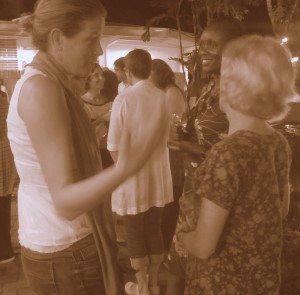 I can’t quite recall who started pointing towards the “What If...” format, but when it showed up three times last week, I knew I should pay attention. I’ve been spending a lot of time with my clients working on meetings talking about alternatives to presentations and panel discussions (which are rarely discussions.) I’ve been using “Celebrity Interviews” (aka “Chat Shows“) and “Fishbowls” (or variants such as the “Samoan Circle“).
I can’t quite recall who started pointing towards the “What If...” format, but when it showed up three times last week, I knew I should pay attention. I’ve been spending a lot of time with my clients working on meetings talking about alternatives to presentations and panel discussions (which are rarely discussions.) I’ve been using “Celebrity Interviews” (aka “Chat Shows“) and “Fishbowls” (or variants such as the “Samoan Circle“).
According to co-founder Matt Murrie, What If lends itself to a learning frame, versus information delivery, with the onus for stimulating the learning on the questions the Questioneers (as alternative to presenters) ask. Then it flows to a conversation cafe-like or World Cafe format of small group discussions.
In live and virtual events, Questioneers (the question askers) ask thought-provoking questions in eight minute talks, followed by lengthy breaks for interaction among the off-stage presenters (the audience).
So as usual, it all comes down to the power of a) questions and b) conversation. I hope you are not surprised!
I’m looking forward to trying this out. If you have used this approach, I’d love to hear your stories.
I try to do this when the group is small enough to be interactive and the subject is something I have reasonable command of. I do science and questions are the core technique – a great science class will stress this and make it – at least as much as possible – part of the interaction.
When I consult I sometimes use it – usually people just want an information dump and answers:( But there are a few who want to lose the training wheels and go in more deeply. Those are delightful interactions, but properly done they are much more difficult than normal presentations or panels.
Some warnings and caveats. You need to be able to sense the flow of conversation and be able to steer it. Some kind of visual note taking helps. There should be some reference to authority for guidance – many of mine involve a lot of on-the-fly physics and math – other subject areas will have their own scratchpads and you need to be able to pull it off smoothly. Small groups are a plus and knowing some or most of the people is a real plus. It can be difficult when there is a wide range of backgrounds and questions – but that can also be a feature. It is very easy to fail, but there is great learning potential.
Steve, how do we break the “people just want an information dump” thing? Plus, I appreciate the practice notes. USEFUL! THanks!(and of course, I’m always willing to fail in the service of learning!)
I wish I had an answer Nancy. I try to offer this early on with new clients or if I perceive a change within an organization that indicates people might want to go deeper. I tell them I’ll give them the information dump if they want, but it will be less useful than if we take time to explore together and try to understand the problem and issues more fully. After all – I’m just guessing at their needs and, more often than not, so are they.
You’ve probably seen the general outline I made to solve problems when I was an undergrad (mentioned in this blog post http://tingilinde.typepad.com/omenti/2013/04/placetime.html ). I still find it useful and concentrate on the first two sections as appropriate and try to make it as interactive as possible. I tell them I’m failing if I’m talking more than a quarter of the time.
Usually small groups of under 15 work best – one on one or two on one can be even better as it can be a socratic mentorship. I call them exploration workshops. One of the most interesting was with an animation company. I did it for free as I’m on one of their boards. They were investigating creativity and forcing people to think differently about problems and tools. I proposed to teach people how to use slide rules to free up their minds for certain types of calculations (there is a lot of math in animation). Here I was teaching an electrified audience how to use a tool that hasn’t seen serious use in 40 years. They were teaching each other and I still get emails suggesting interesting ways to look at established tools. I was really up to teaching something quite different from slide rule use. Management had asked me if it is possible to get already creative people thinking outside their field. The hardest part was finding enough student slide rules.
Of course these sessions are usually much closer to the problem at hand. Now if I could only find more clients interested in this kind of interaction…. it really is fun (and sometimes exhausting)